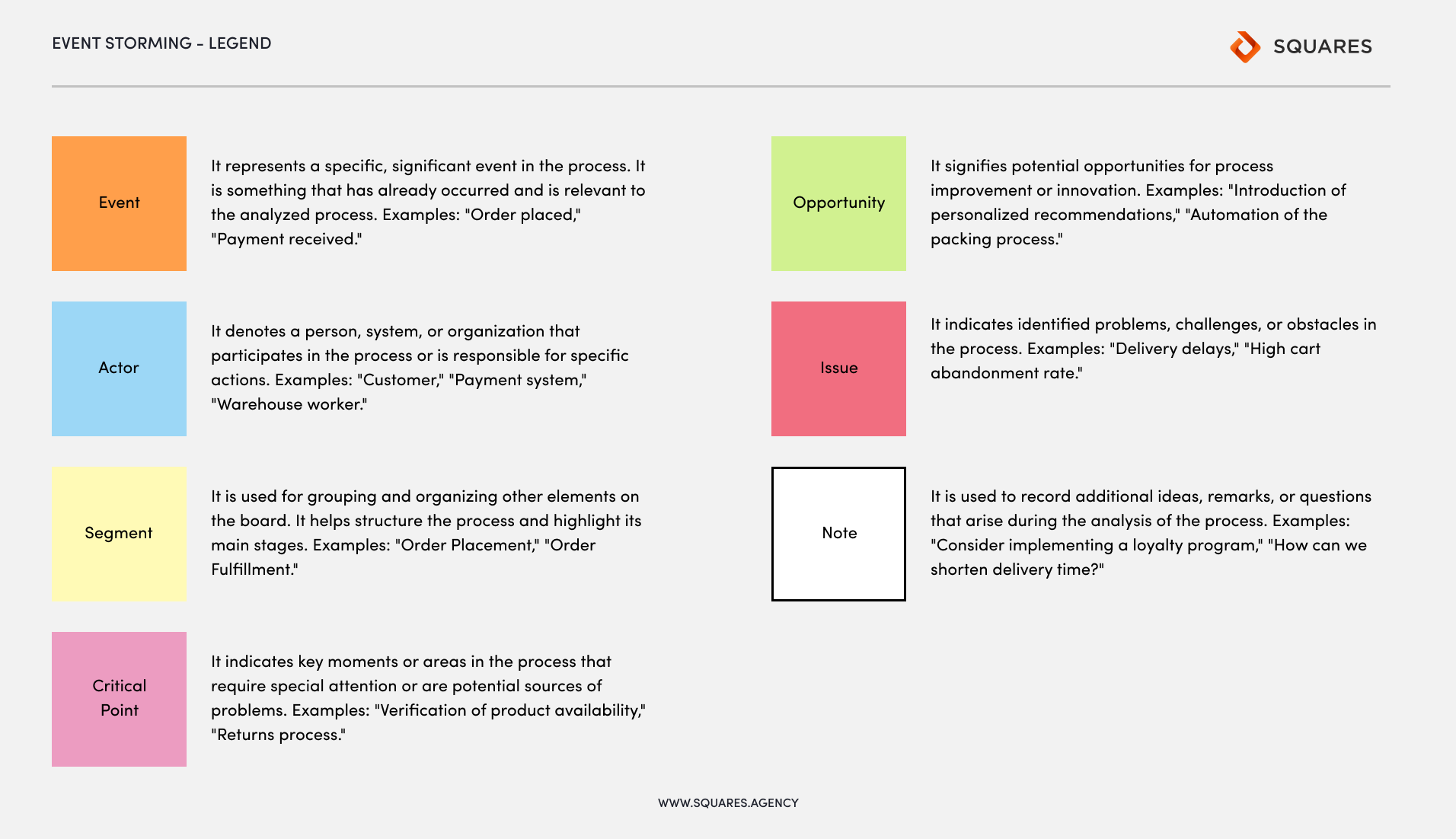What is Event Storming

Have you ever wondered how to streamline processes in your company and better understand how your product functions? Event Storming may be the answer to your questions. The modern business world requires not only innovative tools but also effective teamwork methods. Event Storming, as a business process modeling technique, is an excellent solution that supports product planning and development. In this article, you will learn what Event Storming is, its significance for product development, and how to conduct product workshops step by step.
What is Event Storming?
Event Storming is a business process modeling technique initiated by Alberto Brandolini in 2012. This tool allows for the quick and effective understanding of complex processes as well as the identification of bottlenecks and improvements. Event Storming involves organizing workshops where project teams collaboratively analyze the processes and events occurring within a given system or project.
The main goal of Event Storming is to bring to light all relevant events and operations occurring in the system. This technique makes it easier to see which elements of the system require improvement and which are functioning properly. During the workshops, sticky notes, markers, and large working surfaces are typically used, promoting creative thinking and open communication among participants.

Why It’s Worth Using Event Storming in Product Development
Event Storming plays a key role in the product development process. This technique allows for quicker identification of problems and anticipation of potential difficulties, enabling more effective planning and implementation of changes.
Faster Problem Identification Process
One of the greatest advantages of Event Storming is that it enables the team to quickly identify and discuss existing issues. Through the visualization of processes and events, workshop participants can more easily understand where the main bottlenecks lie and what the potential problem areas are.
Enabling Open Communication
Event Storming fosters open communication within the team. Every workshop participant has the opportunity to express their opinions and contribute to the project. This work dynamic allows for a better understanding of different perspectives and collaboratively developing optimal solutions.
Better Planning and Implementation of Changes
Once all key elements of the process are identified and displayed on a board, teams can plan and implement changes more effectively. Event Storming helps minimize the risk of errors and misunderstandings, contributing to better project management and a higher level of project completion.

How to Conduct Event Storming
Conducting an Event Storming workshop requires proper preparation and adherence to several key steps. Below is a detailed guide on how to organize an effective Event Storming workshop.
Step 1: Preparation
Before you begin the Event Storming, you need to thoroughly prepare for the workshop. Here’s what should be on your to-do list:
- Choosing the Right Venue: Ensure you have a space that allows for free movement and work on large surfaces.
- Preparing Materials: Make sure you have a sufficient supply of sticky notes in various colors, markers, and large sheets of paper or whiteboards.
- Team Composition: Invite all key stakeholders of the project, meaning those who have in-depth knowledge of the processes and systems that will be discussed.
Step 2: Introduction to the Topic
At the beginning of the workshop, the team leader should briefly present the purpose and scope of the Event Storming session. It is important for all participants to have a clear understanding of what is being analyzed and what the expected outcomes are, e.g., redesigning the purchasing path for product X or creating the architecture for application Y. Event Storming allows for great flexibility regarding the specific goals of the exercise.
Step 3: Identifying Events

Participants in the workshops begin by identifying all significant events that occur within the analyzed process. Each event is recorded on a separate sticky note and placed on the board in a chronological order.
Imagine that you are creating a map of an online store. This map shows what happens from the moment someone wants to buy something until they receive their order. Often in Squares, we use a method called “Reverse Event Storming” or “Backward Event Storming.” In this variant of Event Storming, instead of starting from the beginning of the process and moving toward the end, the team begins with the final outcome or goal and works backward, identifying the events that led to that end state. The choice of format primarily depends on the team’s preferences; however, based on experience, the latter approach tends to yield better results.

How to Start Identifying Key Events?
Begin with orange sticky notes. Write down the sequential events that occur. In event storming, events should be recorded in the past tense, as they represent facts that have already happened. For example:
- The customer selected a product and clicked “Buy.”
- The store checked the product’s availability.
- The customer paid for the purchase.
- The warehouse employee packed the product.
- The courier picked up the package.
- The package arrived at the buyer’s location.

Adding User Roles
Now, add blue sticky notes. On these, write down who participates in the process. For example: buyer, store employee, courier.

Dividing the Process into Segments
Yellow sticky notes will help you break the entire process into parts. Start by thinking about what the main phases of your process are. For an online store, these might be: “Browsing and Selection,” “Order,” “Payment,” “Shipping,” and “Delivery.” Write these names on yellow sticky notes and place them on the board.
Now you can group relevant events and other elements under them. This will help you see how different parts of the process connect with each other. Remember that this structure is not rigid—you can change it as you work if you notice that something fits better elsewhere.

Critical Points (Hot Spots)
Critical points, marked with pink sticky notes, are key moments in the process that require special attention. These are places where problems may arise or where the process is particularly vulnerable to errors.
When identifying hot spots, think about the moments that often cause difficulties or are crucial for customer satisfaction. For example, in an online store, one such point could be “Verifying Product Availability“—what if the system displays incorrect information? Another example is the “Payment Process“—how do you handle failed transactions?
Placing pink sticky notes on the board helps focus the team’s attention on these critical moments, allowing for deeper analysis and planning for improvements. Remember that identifying hot spots is not criticism but an opportunity to enhance the process.

Discovering Opportunities
Green sticky notes, representing opportunities, are used to jot down ideas for improving the process or introducing innovations. This is a space for creative thinking about how to enhance customer experience or operational efficiency.
Consider what could make your store better or more competitive. For instance, “Package Tracking Capability” could increase customer satisfaction by providing them with a sense of control over their order. Similarly, “Recommending Similar Products” could boost sales and enhance the shopping experience.
By placing green sticky notes on the board, you create a space for discussion about potential improvements. This is a way to look towards the future and plan the development of your store.

Recording Ideas and ‘Parking Lot’ Topics
White sticky notes are used to capture ideas, remarks, and comments that arise during the mapping process. This space is for free thoughts that may not fit into other categories but can be valuable for understanding or improving the process.
While working on the map, write down everything that seems relevant or interesting on the white sticky notes. This could be a question that requires further exploration, an idea for future improvement, or an observation about the current state of the process. For example, you might note down, “Do we need additional training for customer service?” or “Consider implementing a loyalty program.”
Remember, you can change and move the sticky notes, and this is a natural part of the process. The goal is to collaboratively create a picture that shows how your online store operates and what can be improved.
Additional Section – Issues

Often, we also add an ‘Issues’ section using red sticky notes. This category is used to identify what is currently not working or is particularly challenging in the process.
On the red sticky notes, write down specific problems you are facing. These could be recurring difficulties, bottlenecks in the process, or areas generating the most customer complaints. For example, you might note down, “Long wait times for customer service” or “Frequent errors in the payment system.”
Placing these issues on the board helps the team focus on the most important challenges. This is the first step toward finding solutions and prioritizing corrective actions. Remember, the goal is not to criticize but to genuinely identify areas needing improvement, ultimately leading to enhancements in the entire process.
Step 4: Drawing Conclusions and Planning Actions
At the end of the workshop, the team analyzes the entire event map and draws key conclusions. Based on the gathered information, specific corrective and improvement actions are planned.

Event Storming and Product Workshops – Is It Worth It?
Product workshops can offer numerous benefits for organizations, especially in the context of developing new products and improving existing solutions. Let’s take a closer look at why investing in such workshops is worthwhile.
Learn more about Product Workshops
Summary and Key Takeaways
Event Storming is a powerful tool that supports product development and enhances business processes. This technique allows for the quick identification of problems and effective planning of corrective actions. On the other hand, product workshops enable teams to collaborate on the development and optimization of products, fostering creativity and better communication.
Utilizing these techniques can bring many advantages to organizations; however, they require proper preparation and commitment from participants. Therefore, it is essential to invest time and resources in developing workshop skills to fully reap the benefits of these modern teamwork methods.


